AEGINA / AIGINA 350BC Ancient Silver Greek Drachm Coin LAND TORTOISE NGC i58228
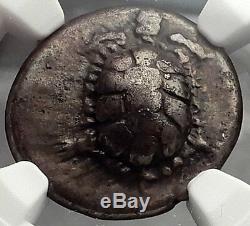
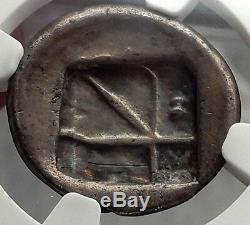

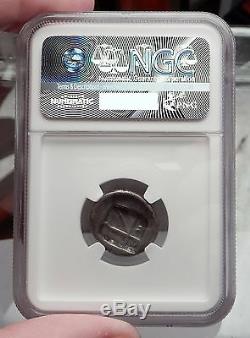
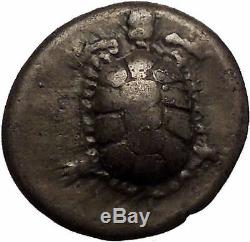
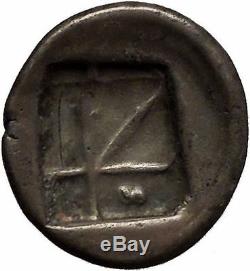
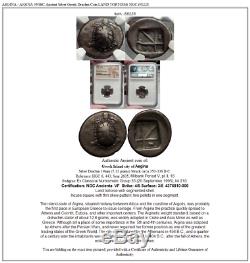

Item: i58228 Authentic Ancient coin of. Greek Island city of Aegina Silver Drachm 19mm (5.11 grams) Struck circa 350-338 B. Reference: HGC 6, 443; Sear 2605; Milbank Period V, pl. II, 16 Pedigree: Ex Classical Numismatic Group 35 (20 September 1995), lot 210.
Certification: NGC Ancients VF Strike: 4/5 Surface: 3/5 4375810-006 Land tortoise with segmented shell. Incuse square with thin skew pattern; two pellets in one segment. The island-state of Aigina, situated midway between Attica and the coastline of Argolis, was probably the first pace in European Greece to issue coinage. From Aigina the practice quickly spread to Athens and Corinth, Euboia, and other important centers. The Aiginetic weight standard, based on a didrachm-stater of about 12.6 grams, was widely adopted in Crete and Asia Minor as well as Greece. Although sill a place of some importance in the 5th and 4th centuries, Aigina was eclipsed by Athens after the Persian Wars, and never regained her former position as one of the greatest trading states of the Greek World. The city was captured by the Athenians in 456 B.And a quarter of a century later the inhabitants were expelled from the island. After the fall of Athens, the exiles were restored to their homes. Is one of the Saronic Islands of Greece in the Saronic Gulf , 17 miles (27 km) from Athens. Tradition derives the name from Aegina, the mother of Aeacus , who was born in and ruled the island. During ancient times, Aegina was a rival to Athens , the great sea power of the era.
The island, along with offshore islets, comprises the Municipality of Aegina in Piraeus Prefecture , a part of the Attica region. The capital is the town of Aegina pop. 7,410 in 2001 census, situated at the northwestern end of the island. Due to its proximity to Athens, it is a popular quick getaway during the summer months, with quite a few Athenians owning second houses on the island.
Besides the town of Aegina, the largest other towns and villages on the island are Kypséli pop. 1,949, Vathý (1,474), Mesagrós (682), Pérdika (682), Agía Marína (426), Vaïa (239), Álones (233), and Kontós (178). Aegina is roughly triangular in shape, approximately 15 km (9.3 mi) from east to west and 10 km (6.2 mi) from north to south, with an area of about 87 km. An extinct volcano constitutes two thirds of Aegina. The northern and western side consist of stony but fertile plains, which are well cultivated and produce luxuriant crops of grain , with some cotton , vines , almonds , olives and figs , but the most characteristic crop of Aegina today (2000s) is pistachio.
Economically, the sponge fisheries are of notable importance. The southern volcanic part of the island is rugged and mountainous, and largely barren. Its highest rise is the conical Mount Oros (531 m) in the south, and the Panhellenian ridge stretches northward with narrow fertile valleys on either side. The beaches are also a popular tourist attraction.
Hydrofoil ferries from Piraeus take only forty minutes to reach Aegina; the regular ferry takes about an hour, with ticket prices for adults within the 4-15 euro range. There are regular bus services from Aegina town to destinations throughout the island such as Agia Marina. Prehistoric archaeological findings of settlements with obsidian tools points to an early habitation of the island. Earliest history (20th7th centuries BC). Aegina, according to Herodotus , was a colony of Epidaurus , to which state it was originally subject. Its placement between Attica and the Peloponnesus made it a center of trade even earlier, and its earliest inhabitant came from Asia Minor. Minoan ceramics have been found in contexts of ca.The discovery in the island of a number of gold ornaments belonging to the latest period of Mycenaean art suggests the inference that the Mycenaean culture held its own in Aegina for some generations after the Dorian conquest of Argos and Lacedaemon. It is probable that the island was not doricized before the 9th century BC. One of the earliest historical facts is its membership in the League of Calauria Calaurian Amphictyony , ca. 8th century BC, which included, besides Aegina, Athens , the Minyan (Boeotian) Orchomenus , Troezen , Hermione , Nauplia and Prasiae , and was probably an organization of city-states that were still Mycenaean, for the purpose of suppressing piracy in the Aegean that arose as a result of the decay of the naval supremacy of the Mycenaean princes. Aegina appears to have belonged to the Eretrian league during the Lelantine War ; hence, perhaps, we may explain the war with Samos , a leading member of the rival Chalcidian league in the reign of King Amphicrates Herod.
Not later than the earlier half of the 7th century BC. Rise as a sea power (6th5th centuries BC). It follows, therefore, that the maritime importance of the island dates back to pre- Dorian times.
It is usually stated on the authority of Ephorus , that Pheidon of Argos established a mint in Aegina. For example, Kydonia on Crete began minting coins by over-striking Aeginian specimens.
Thus it was the Aeginetes who, within 30 or 40 years of the invention of coinage by the Lydians c. 700 BC, introduced coinage to the western world. The fact that the Aeginetan scale of coins, weights and measures (developed in the mid-7th century) was one of the two scales in general use in the Greek world (the other being the Euboic-Attic) is sufficient evidence of the early commercial importance of the island.
During the naval expansion of Aegina during the Archaic Period , Kydonia was an ideal maritime stop for Aegina's fleet on its way to other Mediterranean ports controlled by the emerging sea-power Aegina. During the next century Aegina is one of the three principal states trading at the emporium of Naucratis , and it is the only state of European Greece that has a share in this factory.
At the beginning of the 5th century it seems to have been an entrepôt of the Pontic grain trade, at a later date an Athenian monopoly. Unlike the other commercial states of the 7th and 6th centuries BC, such as Corinth , Chalcis , Eretria and Miletus , Aegina founded no colonies.The settlements to which Strabo refers viii. 376 cannot be regarded as any real exceptions to this statement.
Rivalry with Athens (5th century BC). The history of Aegina, as it has come down to us, is almost exclusively a history of its relations with the neighbouring state of Athens, which began to compete with the thalassocracy of Aegina at the beginning of the sixth century. Solon passed laws limiting Aeginetan commerce in Attica. The legendary history of these relations, as recorded by Herodotus v. 49-51, 73, 85-94, involve critical problems of some difficulty and interest.
He traces back the hostility of the two states to a dispute about the images of the goddesses Damia and Auxesia , which the Aeginetes had carried off from Epidauros , their parent state. Upon the refusal of the Aeginetes to continue these offerings, the Athenians endeavoured to carry away the images. No date is assigned by Herodotus for this old feud ; recent writers, e. Macan, suggest the period between Solon and Peisistratus, circa 570 BC. It may be questioned, however, whether the whole episode is not mythical.Of the kneeling posture of the images of Damia and Auxesia, of the use of native ware instead of Athenian in their worship, and of the change in women's dress at Athens from the Dorian to the Ionian style. The account which Herodotus gives of the hostilities between the two states in the early years of the 5th century BC is to the following effect. Thebes , after the defeat by Athens about 507 BC, appealed to Aegina for assistance.
The Aeginetans at first contented themselves with sending the images of the Aeacidae , the tutelary heroes of their island. Subsequently, however, they entered into an alliance, and ravaged the seaboard of Attica. The Athenians were preparing to make reprisals, in spite of the advice of the Delphic oracle that they should desist from attacking Aegina for thirty years, and content themselves meanwhile with dedicating a precinct to Aeacus , when their projects were interrupted by the Spartan intrigues for the restoration of Hippias. In 501 BC Aegina was one of the states which gave the symbols of submission (earth and water) to Achaemenid Persia.
Athens at once appealed to Sparta to punish this act of medism , and Cleomenes I , one of the Spartan kings, crossed over to the island, to arrest those who were responsible for it. His attempt was at first unsuccessful; but, after the deposition of Demaratus , he visited the island a second time, accompanied by his new colleague Leotychides , seized ten of the leading citizens and deposited them at Athens as hostages. After the death of Cleomenes and the refusal of the Athenians to restore the hostages to Leotychides, the Aeginetans retaliated by seizing a number of Athenians at a festival at Sunium.Thereupon the Athenians concerted a plot with Nicodromus , the leader of the democratic party in the island, for the betrayal of Aegina. He was to seize the old city, and they were to come to his aid on the same day with seventy vessels.
The plot failed owing to the late arrival of the Athenian force, when Nicodromus had already fled the island. An engagement followed in which the Aeginetans were defeated.
Subsequently, however, they succeeded in winning a victory over the Athenian fleet. All the incidents subsequent to the appeal of Athens to Sparta are expressly referred by Herodotus to the interval between the sending of the heralds in 491 BC and the invasion of Datis and Artaphernes in 490 BC cf. There are difficulties in this story, of which the following are the principal elements. Herodotus nowhere states or implies that peace was concluded between the two states before 481 BC, nor does he distinguish between different wars during this period. Hence it would follow that the war lasted from shortly after 507 BC down to the congress at the Isthmus of Corinth in 481 BC. It is only for two years (490 and 491) out of the twenty-five that any details are given. It is the more remarkable that no incidents are recorded in the period between Marathon and Salamis , since at the time of the Isthmian Congress the war is described as the most important one then being waged in Greece Herod. It is improbable that Athens would have sent twenty vessels to the aid of the Ionians in 499 BC if at the time she was at war with Aegina. There is an incidental indication of time, which points to the period after Marathon as the true date for the events which are referred by Herodotus to the year before Marathon, viz. The thirty years that were to elapse between the dedication of the precinct to Aeacus and the final victory of Athens Herod. The ruins of the Temple of Apollo. As the final victory of Athens over Aegina was in 458 B. The thirty years of the oracle would carry us back to the year 488 BC as the date of the dedication of the precinct and the outbreak of hostilities. This inference is supported by the date of the building of the 200 triremes for the war against Aegina on the advice of Themistocles , which is given in the Constitution of Athens as 483-482 BC Herod.It is probable, therefore, that Herodotus is in error both in tracing back the beginning of hostilities to an alliance between Thebes and Aegina c. 507 BC and in putting the episode of Nicodromus before Marathon. Overtures were unquestionably made by Thebes for an alliance with Aegina c.
507 BC, but they came to nothing. The refusal of Aegina was veiled under the diplomatic form of sending the Aeacidae.
The real occasion of the outbreak of the war was the refusal of Athens to restore the hostages some twenty years later. There was but one war, and it lasted from 488 to 481. That Athens had the worst of it in this war is certain. Herodotus had no Athenian victories to record after the initial success, and the fact that Themistocles was able to carry his proposal to devote the surplus funds of the state to the building of so large a fleet seems to imply that the Athenians were themselves convinced that a supreme effort was necessary.
It may be noted, in confirmation of this view, that the naval supremacy of Aegina is assigned by the ancient writers on chronology to precisely this period, i. The years 490-480 Eusebius , Chron. In the repulse of Xerxes I it is possible that the Aeginetans played a larger part than is conceded to them by Herodotus. The Athenian tradition, which he follows in the main, would naturally seek to obscure their services. It was to Aegina rather than Athens that the prize of valour at Salamis was awarded, and the destruction of the Persian fleet appears to have been as much the work of the Aeginetan contingent as of the Athenian Herod. There are other indications, too, of the importance of the Aeginetan fleet in the Greek scheme of defence. In view of these considerations it becomes difficult to credit the number of the vessels that is assigned to them by Herodotus 30 as against 180 Athenian vessels, cf. During the next twenty years the Philo-Laconian policy of Cimon secured Aegina, as a member of the Spartan league, from attack.The change in Athenian foreign policy, which was consequent upon the ostracism of Cimon in 461, led to what is sometimes called the First Peloponnesian War, in which the brunt of the fighting fell upon Corinth and Aegina. The latter state was forced to surrender to Athens after a siege, and to accept the position of a subject-ally c. The tribute was fixed at 30 talents.
By the terms of the Thirty Years' Peace (445 BC) Athens covenanted to restore to Aegina her autonomy, but the clause remained a dead letter. In the first winter of the Peloponnesian War (431 BC) Athens expelled the Aeginetans and established a cleruchy in their island. The exiles were settled by Sparta in Thyreatis , on the frontiers of Laconia and Argolis. Even in their new home they were not safe from Athenian rancour.
A force landed under Nicias in 424, and put most of them to the sword. At the end of the Peloponnesian War Lysander restored the scattered remnants of the old inhabitants to the island, which was used by the Spartans as a base for operations against Athens in the Corinthian War. Its greatness, however, was at an end. The part which it plays henceforward is insignificant. It would be a mistake to attribute the fall of Aegina solely to the development of the Athenian navy.
It is probable that the power of Aegina had steadily declined during the twenty years after Salamis, and that it had declined absolutely, as well as relatively, to that of Athens. Commerce was the source of Aegina's greatness, and her trade, which appears to have been principally with the Levant, must have suffered seriously from the war with Persia.
Her medism in 491 is to be explained by her commercial relations with the Persian Empire. She was forced into patriotism in spite of herself, and the glory won by Salamis was paid for by the loss of her trade and the decay of her marine.The completeness of the ruin of so powerful a state finds an explanation in the economic conditions of the island, the prosperity of which rested upon a basis of slave-labour. It is impossible, indeed, to accept Aristotle's cf.
272 estimate of 470,000 as the number of the slave-population; it is clear, however, that the number must have been out of all proportion to that of the free inhabitants. In this respect the history of Aegina does but anticipate the history of Greece as a whole. The constitutional history of Aegina is unusually simple. So long as the island retained its independence the government was an oligarchy.
There is no trace of the heroic monarchy and no tradition of a tyrannies. The story of Nicodromus, while it proves the existence of a democratic party, suggests, at the same time, that it could count upon little support. Pericles called Aegina the eye-sore (leme) of the Peiraeus.
Hellenistic period and Roman rule. Aegina passed with the rest of Greece under the successive domination of Macedon , the Aetolians , Attalus of Pergamum and Rome. Ilya Zlobin, world-renowned expert numismatist, enthusiast, author and dealer in authentic ancient Greek, ancient Roman, ancient Byzantine, world coins & more. Ilya Zlobin is an independent individual who has a passion for coin collecting, research and understanding the importance of the historical context and significance all coins and objects represent. Send me a message about this and I can update your invoice should you want this method.
Getting your order to you, quickly and securely is a top priority and is taken seriously here. Great care is taken in packaging and mailing every item securely and quickly. What is a certificate of authenticity and what guarantees do you give that the item is authentic? You will be very happy with what you get with the COA; a professional presentation of the coin, with all of the relevant information and a picture of the coin you saw in the listing. Additionally, the coin is inside it's own protective coin flip (holder), with a 2x2 inch description of the coin matching the individual number on the COA.
Whether your goal is to collect or give the item as a gift, coins presented like this could be more prized and valued higher than items that were not given such care and attention to. Is there a number I can call you with questions about my order? When should I leave feedback? Please don't leave any negative feedbacks, as it happens sometimes that people rush to leave feedback before letting sufficient time for their order to arrive.
The matter of fact is that any issues can be resolved, as reputation is most important to me. My goal is to provide superior products and quality of service. How and where do I learn more about collecting ancient coins? Visit the "Guide on How to Use My Store" for on an overview about using my store, with additional information and links to all other parts of my store which may include educational information on topics you are looking for. You may also want to do a YouTube search for the term "ancient coin collecting" for educational videos on this topic.The item "AEGINA / AIGINA 350BC Ancient Silver Greek Drachm Coin LAND TORTOISE NGC i58228" is in sale since Thursday, January 12, 2017. This item is in the category "Coins & Paper Money\Coins\ Ancient\Greek (450 BC-100 AD)".
The seller is "highrating_lowprice" and is located in Rego Park, New York. This item can be shipped worldwide.- Composition: Silver
- Certification: NGC
- Denomination: Drachm
- Grade: VF
- Certification Number: 4375810-006

